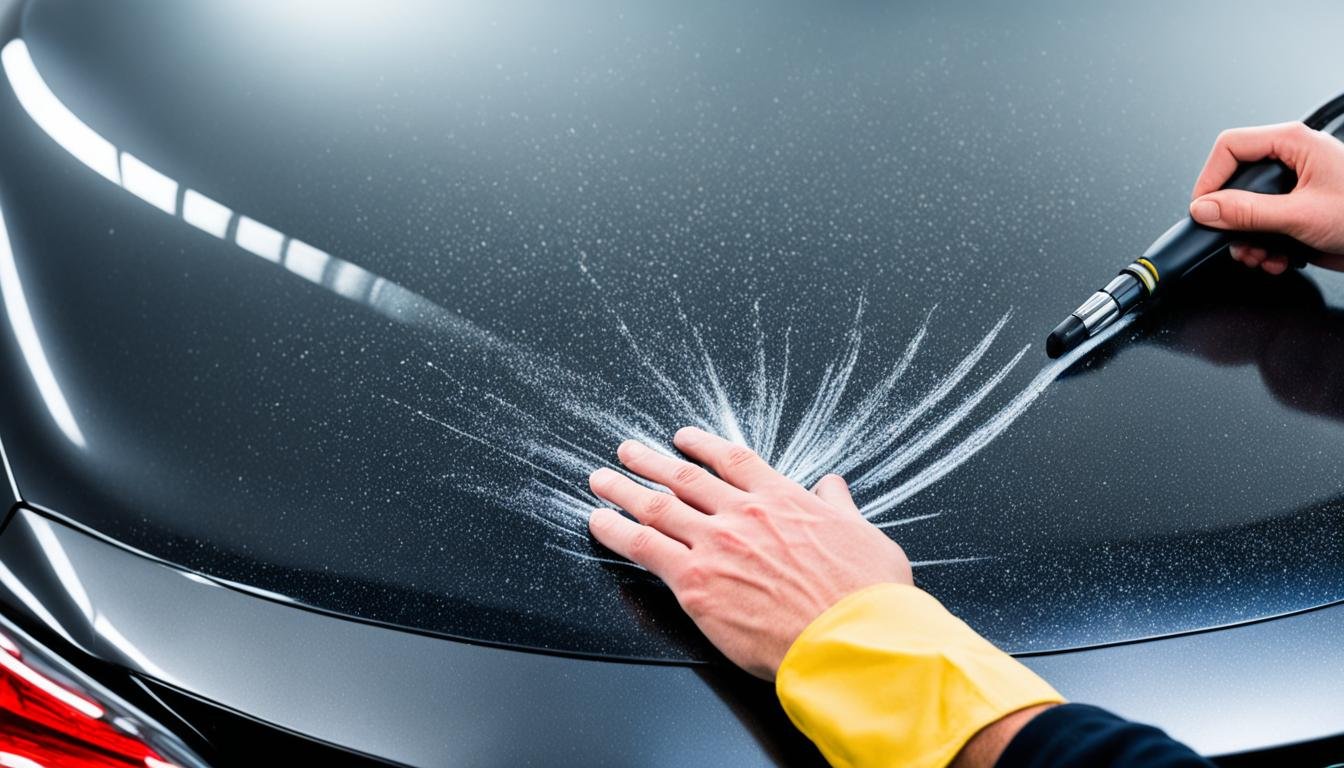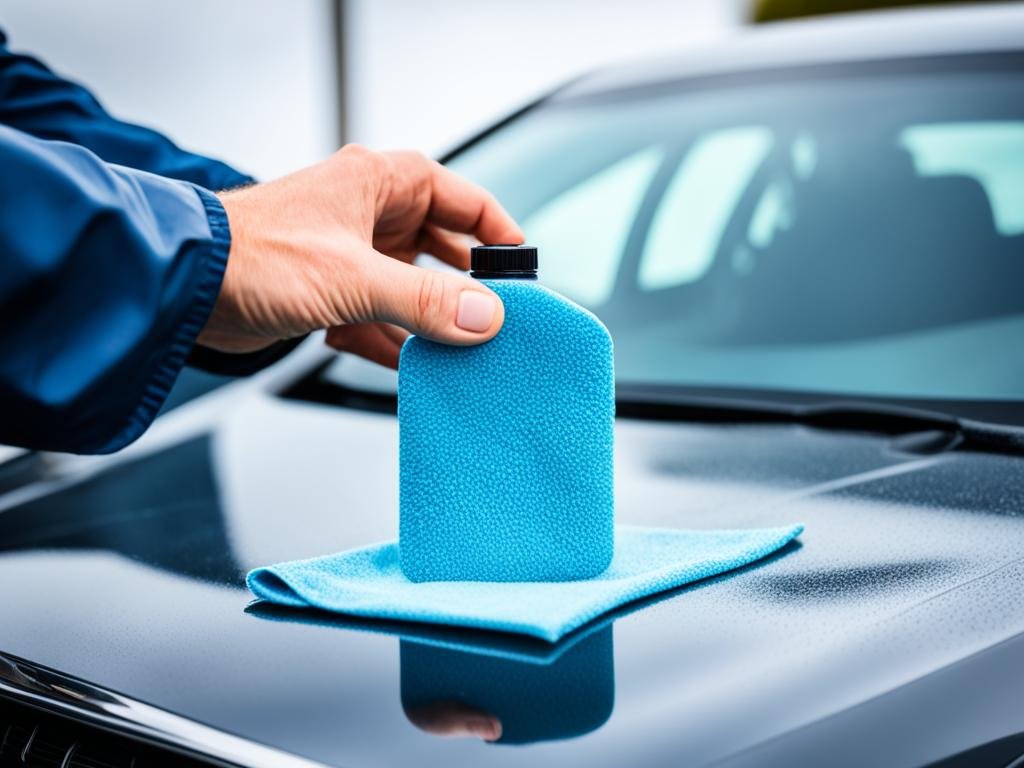How to Use Car Interior Disinfectant
April 11, 2024 | by Rosie Dazzlers

Serving Norfolk and Oxford counties, we bring the shine to you. Whether you drive a sedan or an SUV, Rosie Dazzlers Mobile Auto Detailing offers unmatched convenience and quality right at your doorstep. Trust us to make your vehicle dazzle with our expertise in car cleaning tips, car hygiene practices, and effective car interior disinfection techniques.
With Rosie Dazzlers, you don’t have to worry about finding the time or the right products to clean and disinfect your car interior. We bring our professional services to you, saving you time and effort. Imagine stepping into a vehicle that sparkles with cleanliness and smells fresh, free from germs and bacteria.
Key Takeaways:
- Experience unmatched convenience and quality with Rosie Dazzlers Mobile Auto Detailing.
- We specialize in car cleaning tips, car hygiene practices, and effective car interior disinfection techniques.
- Trust our professional team to bring the shine to your doorstep.
- Enjoy a sparkling clean and germ-free car interior.
- Contact us now to schedule an appointment and let your car shine!
Why Disinfecting the Car Interior is Important
The warm and moist conditions in your car interior create an ideal breeding ground for bacteria and viruses. Bacteria and viruses can be transferred through touch, so it’s crucial to disinfect high-touch areas regularly. Research shows car interiors can harbor dirtier surfaces than public toilets, emphasizing the need for proper disinfection. Gas pumps are also a significant source of germs that can be introduced into the car.
The Importance of Car Hygiene Practices
A car interior is a haven for various microorganisms due to the combination of warmth, moisture, and frequent contact with human hands. It’s essential to prioritize car hygiene practices and take necessary steps to remove germs effectively. Regular cleaning and disinfection routines not only promote a healthier driving environment but also reduce the risk of illness transmission.
“Keeping your car interior clean and germ-free is more important than you might think.”
According to studies, car interiors can harbor more germs and bacteria than public toilets. The warm and humid conditions inside the car, combined with the constant touch and contact with different surfaces, provide an ideal breeding ground for harmful microorganisms. High-touch areas such as the steering wheel, door handles, infotainment system buttons, and gear shifts can become hotspots for bacteria and viruses.
With the recent global health concerns, it’s now more crucial than ever to adopt proper car hygiene practices and make disinfecting the car interior a priority. Regular cleaning and disinfection can help prevent the spread of illnesses within the car and ensure the safety of both drivers and passengers.
“Research shows that car interiors can harbor dirtier surfaces than public toilets.”
– Journal of Applied Microbiology
Gas pump handles are another significant source of germs that can transfer onto your hands and ultimately into the car. It’s essential to disinfect your hands after using gas pumps and regularly clean and sanitize the high-touch areas of your car interior to minimize the risk of germ transmission.

| High-touch areas in a car interior: | Recommended cleaning frequency: |
|---|---|
| Steering wheel | After every use |
| Door handles | After every use |
| Infotainment system buttons | Once a week |
| Gear shifts | Once a week |
By prioritizing regular disinfection of high-touch areas and utilizing proper car cleaning tips, you can significantly reduce the presence of harmful germs inside your car. This practice enhances car hygiene and ensures a healthier driving environment for you and your passengers.
Choosing the Right Disinfectant Products
When it comes to car interior germ removal, selecting the right disinfectant products is crucial. You want to ensure effective car interior disinfection techniques without causing any damage to the surfaces. Here’s what you need to know:
- Safe for Car Interiors: Look for disinfectant products that are specifically designed for car interior use, as they are formulated to be safe on various surfaces such as plastics, leather, fabric, and vinyl.
- Avoid Alcohol-Based Disinfectants: While alcohol-based disinfectants are effective against germs, they can potentially cause damage to car interior materials. Disinfectant sprays that do not contain alcohol are a better choice to prevent any harm.
- Isopropyl Alcohol Dilution: If you prefer using isopropyl alcohol for high-touch areas, make sure to dilute it properly. This will help reduce the risk of any adverse effects on the surfaces. Diluting with water or using pre-diluted isopropyl alcohol solutions designed for automotive use is recommended.
Pro Tip: Always read and follow the instructions on the product labels for proper use and dwell time. This will ensure that you achieve the desired disinfection results without compromising the condition of your car’s interior.
By choosing the right interior car cleaning products, you can effectively remove germs from your car’s surfaces, promoting a cleaner and healthier environment for your daily commute. Remember to prioritize safe and gentle disinfection practices to preserve the quality of your car’s interior.
| Product Type | Features |
|---|---|
| Disinfectant Spray | – Designed for car interiors – Safe on various surfaces – Easy to use and apply |
| Alcohol-Free Wipes | – Convenient for quick disinfection – Gentle on surfaces – Portable and travel-friendly |
| Diluted Isopropyl Alcohol | – Suitable for high-touch areas – Requires proper dilution – Effective against germs |
Steps to Disinfect Car Interior
To effectively disinfect your car interior and maintain a hygienic environment, follow these step-by-step techniques:
1. Collect the necessary tools:
Gather essential cleaning tools to ensure a thorough disinfection process. Here’s what you’ll need:
- A steam cleaner
- A vacuum cleaner
- Microfiber cloths
- Car detailing brushes
2. Vacuum the interior:
Start by vacuuming the car’s interior to remove dirt, debris, and loose particles. Pay special attention to areas prone to collecting dust and dirt, such as the seats, floor mats, and crevices.
3. Clean and disinfect high-touch areas:
Use a disinfectant spray or wipes specifically designed for automotive interiors. Apply the disinfectant to high-touch areas, such as the steering wheel, door handles, seat belts, radio controls, shift levers, armrests, cupholders, and buttons. Ensure that you follow the specified dwell time mentioned on the product packaging before wiping the surfaces clean. This will effectively eliminate harmful germs and maintain a hygienic environment within your car.
4. Consider steam cleaning:
For a deeper sanitization, consider using a steam cleaner on various surfaces of the car interior. Steam cleaning can effectively eliminate bacteria and viruses from upholstery, carpets, and other hard-to-reach areas. Follow the manufacturer’s instructions and safety precautions when using a steam cleaner to avoid damaging the car’s interior.
5. Don’t forget these commonly overlooked areas:
Ensure that you disinfect often overlooked areas in your car as well, including seat belts, head restraints, air conditioning vents, and carpets. These areas can harbor dirt, grime, and allergens, so it’s essential to include them in your disinfection routine.
By following these effective car interior disinfection techniques and incorporating regular car hygiene practices, you can maintain a cleaner and healthier environment inside your vehicle.
Cleaning and Disinfecting Car Seats
When it comes to car hygiene practices, ensuring that your car seats are clean and disinfected is essential. Not only does it contribute to a healthier environment, but it also helps maintain the condition and longevity of your seats.
To start, it’s important to address any stains on your car seats using suitable cleaners. Different types of upholstery may require different cleaning methods, so be sure to follow the manufacturer’s recommendations. Once the stains have been removed, consider shampooing the seats to give them a thorough cleanse.
After the cleaning process, it’s time to disinfect the car seats to eliminate any lingering germs. Choose a disinfectant that is safe for use on car interior surfaces and ensure it is effective against bacteria and viruses. Apply the disinfectant evenly across the seats, making sure to cover all areas.
The recommended dwell time for the disinfectant can vary, so be sure to refer to the product instructions for guidance. Allowing the disinfectant to dwell for the recommended time ensures optimal effectiveness in killing germs.
To further enhance the sanitization process, consider using steam cleaning. Steam cleaning can penetrate deep into the fabric of your car seats, helping to eliminate bacteria and viruses. This method is particularly effective for fabric seats.
If steam cleaning is not feasible, you can alternatively use disinfecting wipes or microfiber cloths to wipe down the seats. Focus on high-touch areas such as the seat edges, armrests, and headrests, ensuring thorough coverage.
It’s important to note that when cleaning leather upholstery, you should exercise caution to avoid using excessive moisture. Leather seats are more sensitive and can be damaged if exposed to too much water. Always follow the manufacturer’s recommendations for cleaning and conditioning leather seats.
Important tip: Excessive moisture on fabric seats can lead to mold and mildew growth. Ensure that the seats are thoroughly dry after cleaning and disinfection to prevent these issues.
Comparison of Cleaning and Disinfection Methods for Car Seats
| Method | Pros | Cons |
|---|---|---|
| Steam Cleaning | – Effective in deep cleaning and sanitizing fabric seats – Penetrates the fabric to eliminate bacteria and viruses |
– Requires specialized equipment – Not suitable for all types of upholstery |
| Disinfecting Wipes | – Convenient and portable – Quick and easy to use |
– May not penetrate deep into fabric seats – Limited coverage on larger areas |
| Microfiber Cloths | – Can be used with disinfectant for effective cleaning – Safe for use on various types of upholstery |
– Requires more effort for thorough coverage – May not eliminate bacteria and viruses as effectively as steam cleaning |
By incorporating regular cleaning and disinfection practices for your car seats, you can ensure a clean and sanitized environment for both yourself and your passengers. Remember to follow the manufacturer’s recommendations for your specific car seat materials to avoid any damage or adverse effects.
Conclusion
Regularly disinfecting your car interior is essential for maintaining a germ-free environment. By focusing on high-touch areas and using appropriate disinfectant products, you can effectively reduce your exposure to harmful germs and prioritize your health and well-being while on the road.
Vacuuming the interior to remove dirt and debris, followed by using disinfectant sprays or wipes on high-touch surfaces, is a crucial step in car hygiene practices. Additionally, incorporating steam cleaning into your car cleaning routine allows for deeper sanitization, ensuring a cleaner and healthier car interior.
Remember to follow proper cleaning techniques and choose disinfectant products that are safe for car interior surfaces. Whether it’s the steering wheel, door handles, or seatbelts, thorough disinfection of these areas will help create a safer environment for you and your passengers.
FAQ
How often should I disinfect my car interior?
It is recommended to disinfect your car interior at least once a week, particularly high-touch areas.
Can I use household disinfectants on my car interior?
It is best to use a disinfectant spray specifically designed for automotive interiors to ensure safety and prevent damage to delicate surfaces.
How long should I let the disinfectant dwell on the surfaces?
Follow the instructions on the product label for the recommended dwell time, usually a few minutes, to allow the disinfectant to effectively kill germs.
Should I wear gloves while disinfecting my car interior?
It is not necessary to wear gloves, but it is recommended to wash your hands thoroughly after completing the disinfection process to minimize the risk of transferring germs.
Can I use disinfecting wipes instead of a spray?
Yes, disinfecting wipes can be used to effectively clean and disinfect high-touch areas. Just ensure that the wipes are safe for use on car surfaces.
How can I prevent mold or mildew growth when disinfecting my car seats?
Avoid excessive moisture on fabric seats and ensure they are completely dry after applying disinfectant. For leather seats, use a leather cleaner and conditioner to maintain their quality.
Source Links
RELATED POSTS
View all



